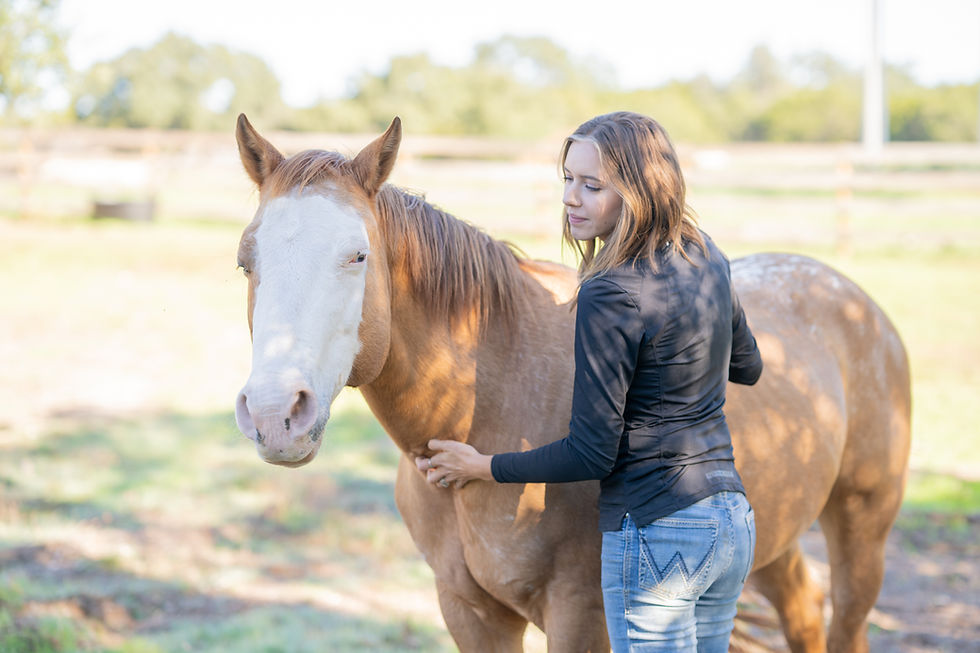Are You Listening? // part one
- Adele Shaw
- May 7, 2018
- 4 min read

I'm very excited to start this new series! I'm calling it the “Are You Listening?” series, #tweAreYouListening on instagram. Originally it began on instragam, but I'd like to also publish it here on my blog for those readers that are not also following me on Instagram (@thewillingequine)
The idea of the series is going to be to take clips of horses doing every day activities (primarily my horses) and “listen” (watch) what they are telling us about how they are experiencing the situation. What this is going to help us do is look PAST plain and simple “obedience” and see TRUE willingness. To understand the emotions they are experiencing, and how they interpret the world around them as well as how they truly feel about interacting with us.
So often we get fixated on whether a horse is being obedient or tolerant... often times mistaking this to mean the horse is happy or willing, but obedience does NOT = willingness. Obedience doesn’t automatically mean the horse LIKES to do what it’s doing. We have to pay attention to micro expressions and subtle behavior cues to understand more about the horse’s emotional state. We have to look past "ears back means mad, ears forward means happy" and really look at the whole picture.
In other words... just because your horse tolerates this or that, doesn’t mean they are happy or willing. Just because they stand still doesn’t mean they aren’t scared. Just because they don’t rear or buck doesn’t mean they aren’t in pain or unhappy.
So let’s talk about this video! The first clip is of my handsome boy Cash. Cash has a LONG history of very harsh training and physical care. He nearly died a couple years ago from being starved and worked to death. Not long after he arrived home we discovered he had a partially dislocated jaw, previously broken ribs, fused vertebra, and much more. Naturally he finds humans and equipment aversive (strong feelings of dislike), especially when they are combined. He’s come a LONG way since he first got home, but every once in awhile I come across something new. Something I either didn’t notice before, or something he’s feeling comfortable communicating to me... like haltering for example. I had wanted to use Cash as an example of teaching a horse to be willingly caught out of the pasture (for my recent YouTube video “what to do when your horse runs away”), when I realized I had missed something! When I was focused on just the haltering all on its own, rather than haltering to take him here or there, I realized Cash wasn’t happy about being haltered.
It’s not that he didn’t want to be with me or work with me, he’ll work at liberty all day long, he’ll even “self halter” when asked, but in the past the halter has caused him tremendous pain.. so he finds the halter a not so pleasant piece of equipment. NOW, because I slowed down long enough to listen, we can start from the beginning (even slower than I’ve done here) and make being haltered a positive experience that’s HIS CHOICE. Not something that he's forced to tolerate. When you watch the comparison video I have at the end, of haltering Pumpkin, it’s SO very clear how unhappy Cash is in comparison. Pumpkin compares being haltered to getting to go to the ice cream shop! Being haltered means good stuff is coming! She loves the halter and being haltered and having the halter on. Her attitude is bright and optimistic, she’s eager and willing, she knows it’s her choice and she’s happy to oblige. THIS is “willingness” in my opinion.
Now, I describe all the visible behavior in each of the clips, but I mention a little something called "appeasement behavior". Appeasement and/or displacement behaviors are behaviors that may be misinterpreted as the horse being disrespectful, ignoring the human, disinterested, or bored, when really they are the horse attempting to communicate conflict or stress. Behaviors that seem odd or out of place for the situation... like turning the head away, side ways ears, tilted head, scratching at the side or leg, grazing, walking away, stretching the head down, licking the lips, and more. These are also called “calming signals”, and they are used by the horse to tell the human (and other horses) that they are uncomfortable or feel pressured and stressed. If you’ll notice Cash turns his head to the side then drops his head to “sniff the ground”. He doesn’t eat, there are no fallen treats... he’s honestly just “sniffing” the ground. Do you really think when I have a pouch full of treats and he has a whole field of lush grass he REALLY cares to just “sniff” the ground? No, probably not. He’s also not ignoring me or being “disrespectful”, but he IS communicating that he feels stressed about the halter. So WHY is it so important to listen to these subtle behaviors? Well, these “quiet” behaviors are the very first step, they are the whisper... the “uh, hey, human... do you think you could please stop?”. These are the behaviors that come BEFORE the flattened ears, the “out of know where with no warning” kicks and bites, the bolts, the rears, the bucks.... sometimes there are many steps between a horse giving a stressed look and bolting... but some horses barely barely give any signs of stress before they escalate because they’ve been taught humans ONLY listen to shouting!
You can show your horse you’re different though! That you can learn to listen! You don’t need to wait for the shouting, you can hear the whisper. Don’t make your horse shout, learn to watch and observe how your horse is feeling. Let them tell you, don’t assume they are okay just because they are obedient.
- Adele




